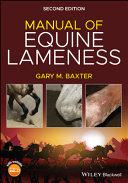Manual of Equine Lameness, 2nd Edition

Revidované druhé vydání je příručka pro diagnostiku a léčbu kulhání u koní. Tato kniha je ideální pro použití jako rychlý zdroj referenčních informací. Poskytuje přímý přístup k základním informacím o kulhání koní, včetně klinického hodnocení koně a běžně prováděných diagnostických nervových blokád a nejběžnějších stavů kopyta. Diskutovány jsou také současné terapeutické možnosti léčby kulhání a také návod, jak zvládat mimořádné události pohybového aparátu. Obsah byl vydestilován z autoritativního sedmého vydání »Adams a Stashak's Lameness in Horses« a toto nové vydání bylo přepracováno tak, aby byla uživatelsky přijatelná, umožňující rychlejší a snadnější orientaci nežli předchozí verze. Barevné fotografie a ilustrace podporují text, který poskytuje informace o kulhání, které jsou nejrelevantnější pro praktické lékaře a studenty veterinární medicíny. Doprovodný web nabízí videa, která se zaměřují na klinické vyšetření koně a vyběr diagnostických bloků a příslušnou anatomii. Diagnostický a léčebný materiál byl oproti předchozímu vydání přepracován tak, aby obsahoval nejaktuálnější informace.
Čtenáři najdou:
Důkladný úvod do hodnocení chromého koně, včetně anamnézy, vizuálního vyšetření, palpace, subjektivního a objektivního hodnocení kulhání, perineurální anestezie a intrasynoviální anestezie.
Vyšetření běžných stavů končetiny, poranění měkkých tkání, stavů kloubů kopyta. Diskuse o nejběžnějších stavech hrudní končetiny, včetně nadprstí, zápěstí, metakarpu/metatarsu, karpu, antebrachia, lokte a pažní kosti, stejně jako ramene a lopatky. Diskuse o běžných stavech pánevní končetiny a axiálního skeletu. Přehled terapeutických možností léčby stavů kulhání a jak zvládat mimořádné události pohybového aparátu u koně
Druhé vydání je ideální pro studenty veterinární medicíny, chovatele koní na začátku kariéry a veterináře smíšených praxí. Je nepostradatelnou referenční příručkou pro každého veterináře, který hledá přehlednou referenční příručku při řešení problematiky kulhání koní.
Autor: Gary M. Baxter
| Nakladatel | Wageningen Academic Publishers |
|---|---|
| ISBN | 9781119747079 |
| Vydání | II. vydání 2022 |
| Vazba | brožovaná |
| Počet stran |
Discover a concise and accessible guide to diagnosing and managing lameness in horses!
The revised Second Edition of »Manual of Equine Lameness« offers a concise and accessible manual of lameness diagnosis and treatment in horses. Perfect for use as a quick reference, this book provides straightforward access to the essentials of equine lameness, including the clinical assessment of the horse and commonly performed diagnostic nerve blocks and the most common conditions of the foot, forelimb, and hindlimb that may be contributing to the lameness. Current therapeutic options to treat lameness are also discussed, as well as guidance on how to manage musculoskeletal emergencies. The content has been distilled from the authoritative Seventh Edition of »Adams and Stashak's Lameness in Horses«, and this new edition has been re-envisioned to be even quicker and easier to navigate than the previous version.
Color photographs and illustrations support the text, which presents lameness information most relevant to equine general practitioners, mixed animal practitioners, and veterinary students. A companion website offers videos that focus on the clinical examination of the horse and select diagnostic blocks and relevant anatomy. Diagnostic and treatment material has been revised from the previous edition to include the most up-to-date information.
Readers will find:
• A thorough introduction to the assessment of the lame horse, including history, visual exam, palpation, subjective and objective assessments of lameness, perineural anesthesia, and intrasynovial anesthesia
• An exploration of common conditions of the foot, including the navicular region and soft tissue injuries, coffin joint and distal phalanx conditions, and laminitis
• Discussions of the most common conditions of the forelimb, including the pastern, fetlock, metacarpus/metatarsus, carpus, antebrachium, elbow, and humerus, as well as the shoulder and scapula
• Discussions of common conditions of the hindlimb and axial skeleton
A review of therapeutic options to treat lameness conditions
• How to manage musculoskeletal emergencies in the horse
Ideal for veterinary students, early career equine practitioners, and mixed animal veterinarians, the Second Edition of »Manual of Equine Lameness« is an indispensable reference for any veterinarian seeking a concise one-stop reference for equine lameness.
Gary M. Baxter, VMD, MS, DACVS, is Professor Emeritus at the University of Georgia College of Veterinary Medicine in Athens, Georgia, USA and Professor Emeritus at Colorado State University College of Veterinary Medicine in Fort Collins, Colorado, USA.
Chapter 1. Assessment of the lame horse
a. History, visual exam and palpation
b. Subjective assessment of lameness
c. Objective assessment of lameness
d. Perineural anesthesia
e. Intrasynovial anesthesia
Chapter 2. Common conditions of the foot
a. Navicular region and soft tissue injuries of the foot
b. Coffin joint and distal phalanx
c. Miscellaneous conditions of the foot
d. Laminitis
e. Foot care and farriery
Chapter 3. Common conditions of the forelimb
a. Pastern
b. Fetlock
c. Metacarpus/metatarsus
d. Carpus
e. Antebrachium, elbow and humerus
f. Shoulder and scapula
Chapter 4. Common conditions of the hindlimb
a. Tarsus
b. Tibia and crus
c. Stifle - femoropatellar region
d. Stifle - femorotibial region
e. Femur and coxofemoral region
Chapter 5. Common conditions of the axial skeleton
a. Pelvis
b. Sacroiliac region
c. Thoracolumbar region/back
d. Neck and poll
Chapter 6. Therapeutic Options
a. Systemic/parenteral
b. Topical/local
c. Intrasynovial
d. Intralesional
e. Oral/Nutritional
f. Rehabilitation/physical therapy
Chapter 7. Musculoskeletal emergencies
a. Severe unilateral lameness
b. Severely swollen limb
c. Long bone fractures/luxations
d. Synovial infections
e. Tendon lacerations